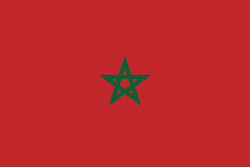Gharb-Chrarda-Béni Hssen (Gharb-Chrarda-Beni Hssen)
The region lacks economic and geographic unity. In particular, while it resembles and is closely connected with the Loukos region which is administrated by the Tanger-Tétouan region, the Gharb is ruled from Kenitra with which it has little connections. Kenitra itself is integrated in the urban corridor that extends southward through Rabat and Casablanca to El Jadida.
The region consisted of the following provinces:
* Kénitra Province (now part of the Rabat-Salé-Kénitra Region)
* Sidi Kacem Province (now part of the Rabat-Salé-Kénitra Region)
* Sidi Slimane Province (now part of the Rabat-Salé-Kénitra Region)
Map - Gharb-Chrarda-Béni Hssen (Gharb-Chrarda-Beni Hssen)
Map
Country - Morocco
 |
 |
| Flag of Morocco | |
In a region inhabited since the Paleolithic era over 300,000 years ago, the first Moroccan state was established by Idris I in 788. It was subsequently ruled by a series of independent dynasties, reaching its zenith as a regional power in the 11th and 12th centuries, under the Almoravid and Almohad dynasties, when it controlled most of the Iberian Peninsula and the Maghreb. In the 15th and 16th centuries, Morocco faced external threats to its sovereignty, with Portugal seizing some territory and the Ottoman Empire encroaching from the east. The Marinid and Saadi dynasties otherwise resisted foreign domination, and Morocco was the only North African nation to escape Ottoman dominion. The 'Alawi dynasty, which rules the country to this day, seized power in 1631, and over the next two centuries expanded diplomatic and commercial relations with the Western world. Morocco's strategic location near the mouth of the Mediterranean drew renewed European interest; in 1912, France and Spain divided the country into respective protectorates, reserving an international zone in Tangier. Following intermittent riots and revolts against colonial rule, in 1956, Morocco regained its independence and reunified.
Currency / Language
| ISO | Currency | Symbol | Significant figures |
|---|---|---|---|
| MAD | Moroccan dirham | د م. | 2 |
| ISO | Language |
|---|---|
| AR | Arabic language |
| FR | French language |















